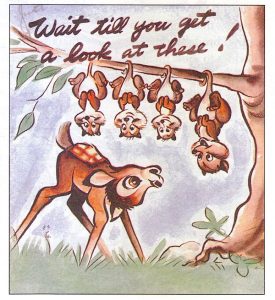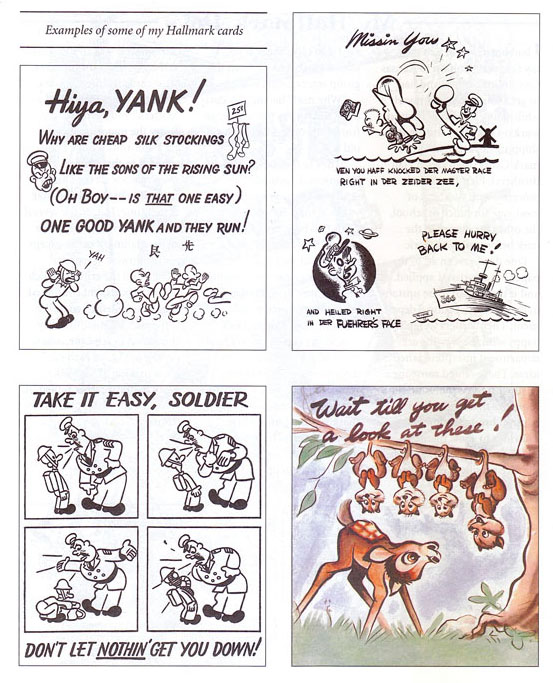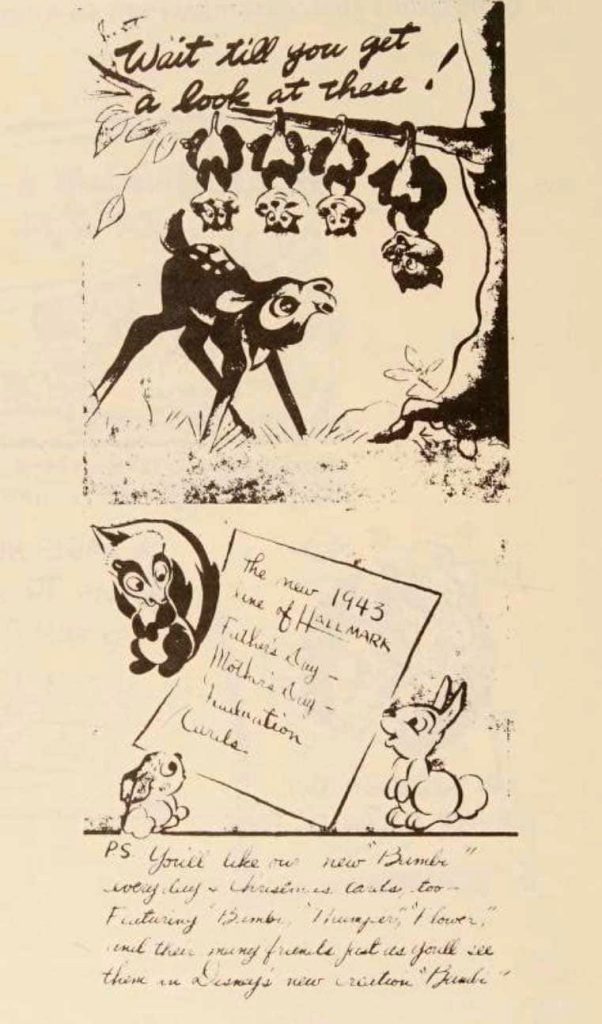If he couldn’t have his own strip, he might still exist, Mort went to work for the Hallmark greeting card company in Kansas City- but not as an artist. “I went to work in the stockroom. This was torment. This place was full of artists and there I was juggling cases of paper clips.”
One day, the Walker eye, forever scanning the help wanted section, noticed a blind ad. Artist Wanted. On his way to work the next day, Mort mailed his application. He might as well have taken it with him. He had answered a Hallmark ad. Called before his boss the next day, Walker faced a quick termination of his stock room duties. “It had to be the end. Either they were going to fire me— or hire me.” They hired him. Within three years every card to come off the Hallmark assembly line bore the okay of a former stock clerk turned head designer.
 This included cards featuring Disney characters, particularly those in Bambi. Every 1942 Bambi card released by Hallmark likely bore Walker’s stamp of approval. Some of Walker’s stories became a little unclear about this point in his career over the years, so it’s hard to tell whether the drawings were all drawn directly by him or were just approved by him as supervisor. However, Mort worked as both designer (drawing cards and creating designs for others) and editor (approving designs) of the Hallmark output.
This included cards featuring Disney characters, particularly those in Bambi. Every 1942 Bambi card released by Hallmark likely bore Walker’s stamp of approval. Some of Walker’s stories became a little unclear about this point in his career over the years, so it’s hard to tell whether the drawings were all drawn directly by him or were just approved by him as supervisor. However, Mort worked as both designer (drawing cards and creating designs for others) and editor (approving designs) of the Hallmark output.
As Mort Walker historian and author of the upcoming book “The Life and Art of Mort Walker,” Bill Janocha pointed out, Walker most likely did not do the artwork of the Bambi cards. Walker may have made the earliest conceived ideas for these cards or may had little to do with them. How much he was involved is something we’ll never actually quite know. However, he was at Hallmark when they were produced, and his family has the original art to one of the cards which is featured in both books about his life. This cards almost definitely at least went through his supervision. But Janocha pointed out that Mort Walker most likely did not craft the Bambi cards by himself. Hallmark was an assembly-line factory, and Mort enjoyed getting paid to conceive concepts and designs but did not get bogged down much with creating finished art by himself.
Mort Walker stated in his book, The Mort Walker Scrapbook, “I also drew all the Disney cards; Bambi was the big star at the time.” This would have been in 1942 when Bambi was just released. Most likely, though, as Brian Walker pointed out, “He might have sketched up ideas for the Disney cards that other artists finished off.” The card with the possums hanging from the tree appears multiple times in this article here for Cartoon Research because it appears in multiple books written by Walker and is the only card that certainly went through Walker at some point in the process whether it was his own roughs, ideas, and/or simply supervising input.

As a child, Mort wrote to Walt Disney as a fan of Disney’s work, and later that letter reentered his life (as seen in the snippet from the now out-of-print The Mort Walker Scrapbook). When writing to Disney, he received a signed photo and an early-mid ‘30s strip from the Phantom Blot storyline. He once said that he had planned on finally meeting Disney during a cross-country trip to CA years later, but Disney backed out at the very end.

 Mort Walker always had a great admiration for Disney and animation in general. When Walker opened the National Cartoon Museum, it was not only a hub for the world of print cartoons and comic books but also an informational hub for animation. Both Walt Disney and Carl Barks were honorees in the William Randolph Hearst Cartoon Hall of Fame at the museum. One of the highlights of the Disney art in Walker’s cartoon art museum was original storyboard sketches from Plane Crazy. As Walker said in his book, “When I first held those drawings in my hand, a chill went up my back. Disney in his wildest dreams would’ve never imagined that these simple little pencil drawings would result in a major movie studio, theme parks all over the world, and billions of dollars of licensed products.” While the Plane Crazy drawings were sold many years ago before the museum closed, most of the Disney art that was once in the National Cartoon Museum is housed at the fabulous Billy Ireland Cartoon Library & Museum at Ohio State University.
Mort Walker always had a great admiration for Disney and animation in general. When Walker opened the National Cartoon Museum, it was not only a hub for the world of print cartoons and comic books but also an informational hub for animation. Both Walt Disney and Carl Barks were honorees in the William Randolph Hearst Cartoon Hall of Fame at the museum. One of the highlights of the Disney art in Walker’s cartoon art museum was original storyboard sketches from Plane Crazy. As Walker said in his book, “When I first held those drawings in my hand, a chill went up my back. Disney in his wildest dreams would’ve never imagined that these simple little pencil drawings would result in a major movie studio, theme parks all over the world, and billions of dollars of licensed products.” While the Plane Crazy drawings were sold many years ago before the museum closed, most of the Disney art that was once in the National Cartoon Museum is housed at the fabulous Billy Ireland Cartoon Library & Museum at Ohio State University.
Unlike some of Mort Walker’s work at Hallmark, it is very unlikely that Mort Walker did the Disney cards by completely himself. There is no doubt though that he had something to do with them. As the editor of Hallmark, they would’ve at least been approved by him when they were being made. Most likely they were designed by others after Mort created the rough concepts. While what exactly his involvement was remains a mystery, they clearly left an impression on him. Janocha points out that in Mort’s youth, he definitely adapted an ‘animation style’ in his cartooning early on using brush. When Bruce Blitz mentioned that Walker had clean and neat style of drawing in a 2000 Cartooning With Blitz interview collected in Jason Whiton’s book Mort Walker Conversations, Walker said, “I learned that from Disney. I loved Disney when I was young. I did all the Disney cards when I worked for Hallmark cards. And I learned how to draw all those simple lines.”

Thanks to Jason Whiton, Bill Janocha, Todd Federman, Greg Walker, and Brian Walker



 Kamden Spies is an animation fan, collector, and aficionado. He received his undergraduate degree in an IDM in film history and creative writing from the University of Alabama at Birmingham and is currently getting his Master’s in Library and Information Sciences at Indiana University Bloomington.
Kamden Spies is an animation fan, collector, and aficionado. He received his undergraduate degree in an IDM in film history and creative writing from the University of Alabama at Birmingham and is currently getting his Master’s in Library and Information Sciences at Indiana University Bloomington.

















































Like R. Crumb, Mort Walker is a cartoonist I never would have expected to work in the greeting card industry. I imagine it must have provided some early professional experience for quite a number of cartoonists in their youth. To me, the military-themed cards definitely look like Walker’s work; the Bambi illustration does not, and I suspect his sole contribution may have been writing the caption.
I liked the Beetle Bailey comic strip when I was a boy, just as I enjoyed the sitcom “Gomer Pyle, USMC”. Both of them made the armed services out to be some sort of summer camp for grown men. I never detected any Disney influence in the comic strip, so it’s nice to see Walker giving Walt some credit; certainly Walker demonstrated that he could draw Mickey, Donald, Goofy and Grumpy well enough. Others may disagree, but when I was growing up I thought the interplay between General Halftrack and Miss Buxley was simply hilarious.
It’s nice that Bambi some some play at the time, since its initial failure at the box office was attributed to its World War II timing: as one animator put it, audiences weren’t in the mood for a sweet little story about please don’t kill the deer.
Another interesting animation connection to Mort Walker is that his sons in 1984 did a short-lived comic strip called ” Betty Boop and Felix” featuring the two animation legends. Here, Betty Boop is Felix’s owner where the cat only speaks in thought balloons (ala Snoopy and Garfield). The strip had little distribution and appeal and ended four years later.
Those cards look better than his strips!
Two decades later, with theater viewership in decline, Mort would be among the general majority of other cartoonists who would make the transition to TV animation when his Beetle Bailey comic strip became an animated TV series. The contrast to the look of the BB series, in quality and substance, certainly proved to be quite stark in comparison to Disney. But considering the style of drawing Mort was accustomed to, I would think the transition did suit him well. However, it wouldn’t surprise me if, at some point in his career, he might’ve gotten an invitation to work at the Disney studio through a chance meeting with one of the Nine Old Men or any one of the veteran artists who’ve worked under them.
Looking at that promotional ad at the center of the article, I’d say the drawing at the bottom half, with the skunk and the two rabbits, could very well be Mort’s work. It has a more simplistic design to it compared to the image of the greeting card shown above it.
A couple of errors, two sentences
“Mort was a Kansas City native whose career evolved by jumping creative and resilient responses to failure. Mort also was an adolescent of the Great Depression.”
“Mort’s main contribution to the Hallmark company was replacing the sappy greeting cards with cards with humor and gags to them, which he believed men were much more likely to purchase.”
were both direct quotes from Mort Walker historian Jason Whiton. I forgot to add a citation by mistake